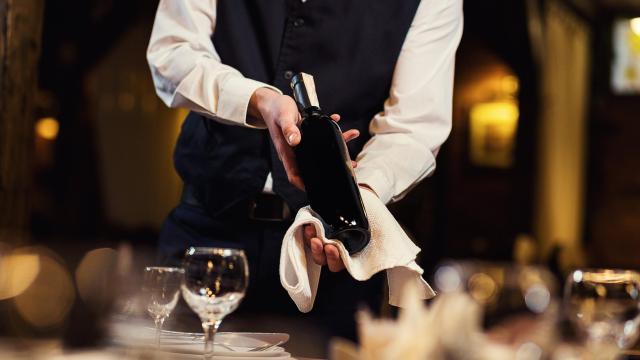We’ve all been there: You head out to a nice restaurant with some friends, settle into your chairs in anticipation…and then the wine list drops in front of you, and suddenly you’re living that dream where you show up for your algebra test naked and everyone laughs at you.
Simply put, there are two fundamental reasons why wine is so challenging. One, no two wines are exactly alike, and bottles within the same variety and category can be wildly different; and two, there’s simply no universal language for wine. There might seem like there is — and wine experts (and amateur snobs) certainly make it seem like there is — but we all experience wine differently. If you say you like sweet red wine, for example, those three simple words can mean wildly different things to different people.
So how can you pick a wine at a restaurant you’ll actually like without tasting each wine on their list or earning a Ph.D. in wineology (which I assume is a thing)? While there’s no guaranteed algorithm that will make it a certainty, you can get a lot closer to wine nirvana if you know what to say and what to ask — and what not to.
Don’t pretend to know more about wine than you do
The first rule of wine club is to admit defeat immediately. Don’t try to act like you know more about wine than you really do, and don’t hesitate to ask for the sommelier. If the restaurant doesn’t have a resident wine expert, ask your server or bartender for a recommendation.
The definition of “good” wine
For our purposes here, “good” wine is whatever wine you like, so take away your ego or any inclinations towards pretentiousness. The only way you’re getting a wine you like is by asking some questions, and if you worry about looking smart or worldly, it’s just going to be a mess.
So just admit it: The only thing you know about wine is what you like. And if what you like costs six bucks at the grocery store, there is no shame in that.
Focus on body and tannins instead of flavour
Don’t focus too much on flavour. A wine might make you think of pears in summer might make someone else think of nectarines with a touch of pine or some other flavour profile. Wine is very personal, so chances are slim that your intimate, primal reaction to a wine will be comprehensible to someone else — even a trained wine professional.
Instead, focus on more objective aspects of the wine. Body is a good starting point — do you like wines that are light and fleeting in your mouth, or wines that are heavy and “oily,” that stick around? You can think of body in terms of milk: Light-bodied is skim, medium is whole, and full-bodies is cream. Just getting this part straight will eliminate more than half the wine list for you. Tannins are also a good, solid clue: Wines high in tannins give you that “puckery” sensation and a slight bitterness, so you can let your server know how tolerant you are of that.
You might think the level of fruit in a wine (as in “fruit forward”) would be objective, but most people confuse this with sweetness (see below) when it really has more to do with the smell and flavour of sweet fruits, and “savoury” or “earthy” wines will remind you more of bitter fruits, like cranberries. Just knowing the kind of fruit you like as a snack can help guide you to a wine you’ll enjoy.
Share examples of wines you know you like
Picking a wine is a conversation, and you’ve got to give your conversation partner the right information to work with. A good place to start is with wine you already know you enjoy, even if it comes in a box. Folks who deal in wine professionally are well aware of the popular, mass-produced brands, so if you can tell them you love Three Buck Chuck with a passion, that gives them something to work with. Again, worry too much about “sounding smart” is your enemy here — the more honest you are about your proletarian taste in wine, the better your chances of coming out a winner.
A great strategy is to take a photo of the label any time you enjoy a wine, and showing your sommelier a few of the bottles you adore. Chances are they’ll know at least a few, and that’ll be all they need to find a taste-alike.
Know the difference between “dry” and “sweet” wines
You might think something like “sweet” would be fairly objective, but it isn’t. Wine enthusiasts have some crazy ideas about what constitutes a “sweet” wine — you can order a “sweet red” and get something that doesn’t seem sweet at all — because almost all wines are categorised as dry, and calling a wine “fruity” doesn’t mean it’s sweet.
If you like sweet wine in the sense of sugar, order a dessert wine. Yes, you can drink a dessert wine with your dinner. You’re an adult who most likely ate a candy bar for breakfast in the not-so-distant past, after all. Or if you like a bit of sweetness but aren’t looking for a dessert wine, the term “off dry” should nudge your sommelier away from the drier wines towards something with a bit more residual sugar.
Ordering wine in a restaurant shouldn’t make you sweat. Wine is to be enjoyed, after all. If you focus on these simple characteristics and take the advice you’re given by the professionals serving you, there’s no reason you can’t find something to love.

Leave a Reply
You must be logged in to post a comment.